
|
|
Für die deutsche Fassung bitte nach unten scrollen
|
|
|
|
Visit Us at Salzburger Festspiele
from 13 to 21 August!
|
|
|
|
|
Our Highlight of the Month:
|
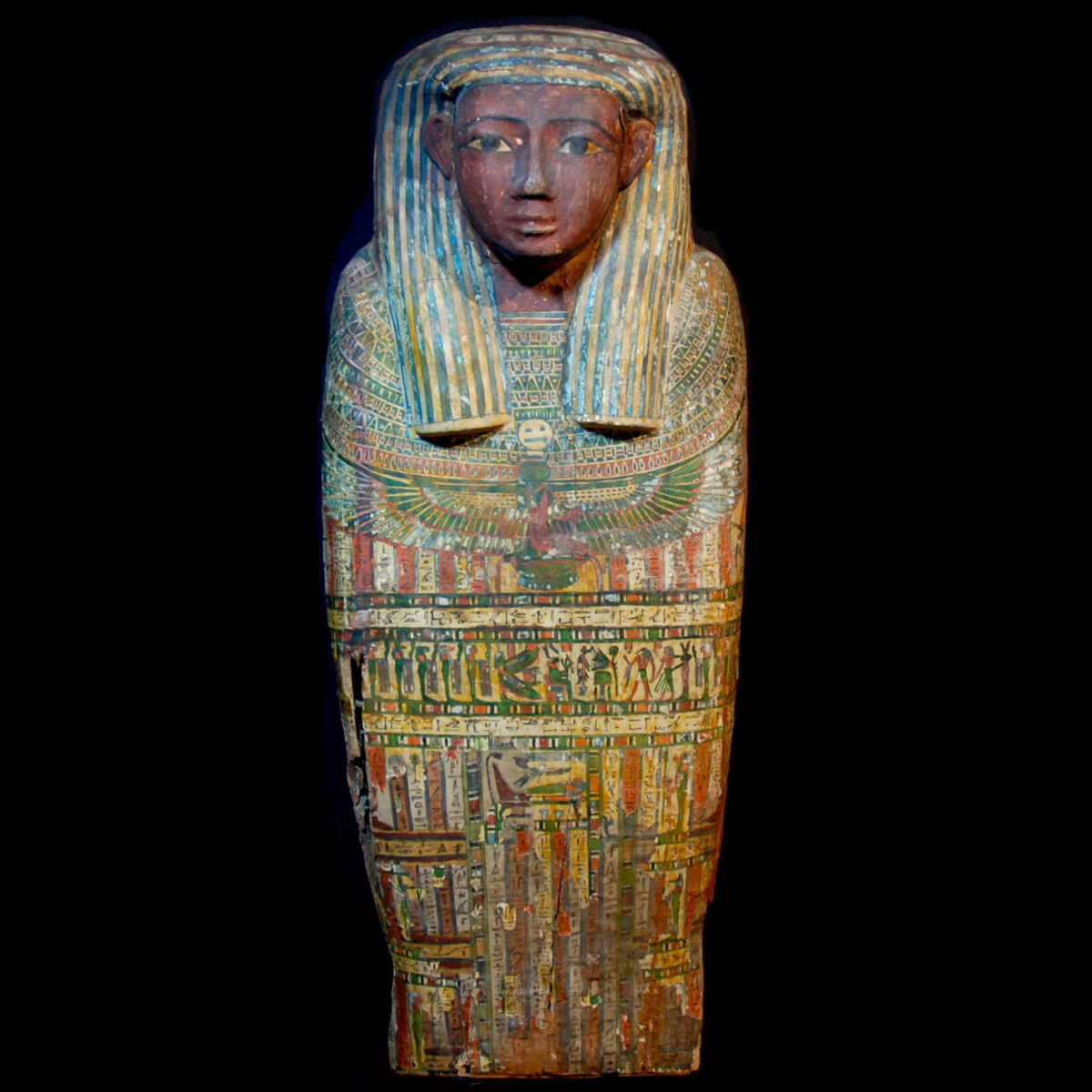
|
|
|
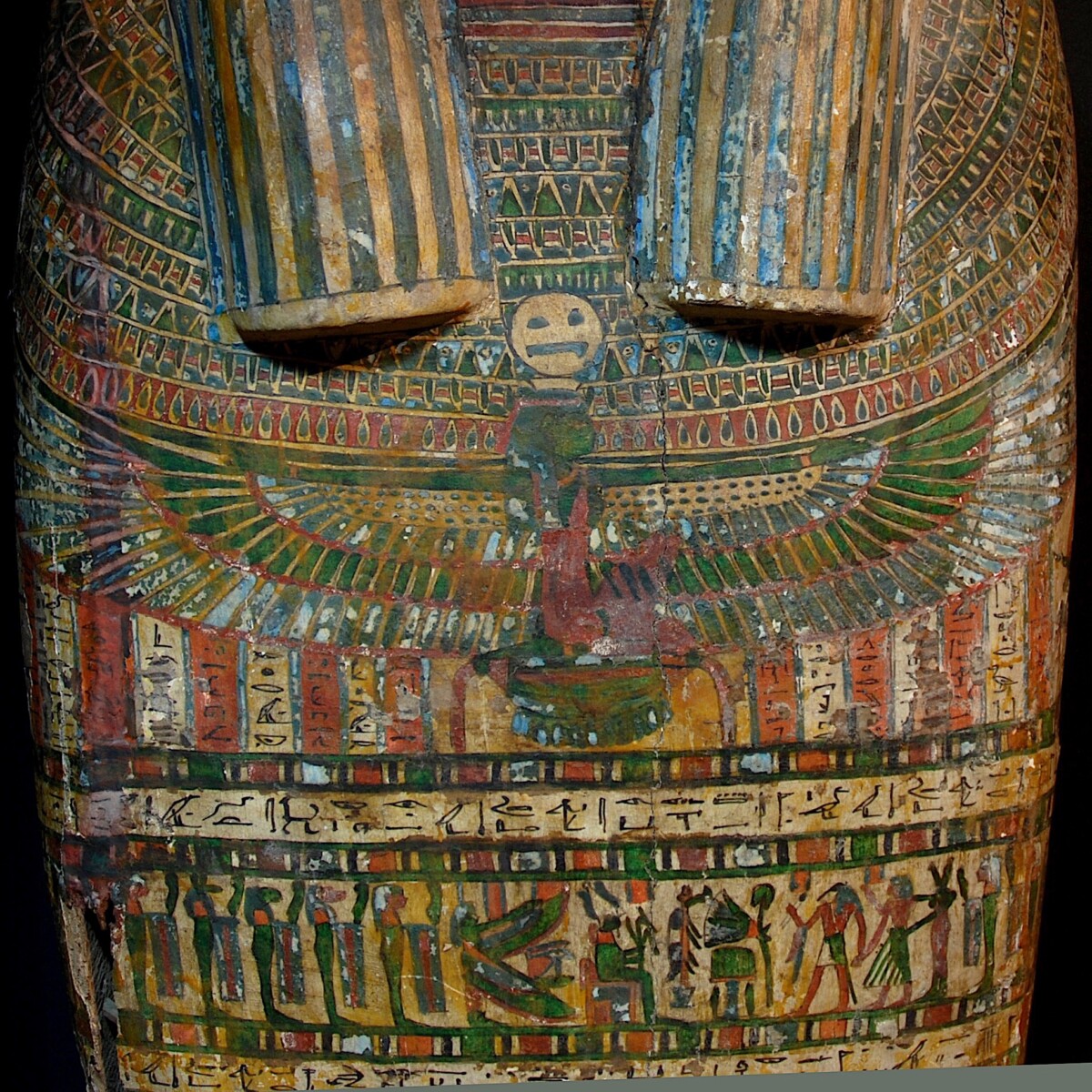
|
|
Egypt – Late period, 26th dynasty, 664-525 B.C.
|
Exceedingly decorative, as well as colorfully painted and inscribed sarcophagus lid dating to the 26th dynasty. The inscription mentions as the owner the divine father Wennefer, son of the divine father of Amun with the name Min-ir-dis, born by the lady of the house Djet-Mut. The face is painted red, eyes, brows and beard in black. At the face end a recess for the separately worked out false beard, which is missing today. The tripartite wig is striped, the ears protruding. The broad usekh collar ends at the shoulders with falcon heads. Below the figure of the winged sky goddess Nut, her name inscribed with hieroglyphs in the sun disk, which she carries on her head. On the left edge of the sarcophagus a ram painted in green with wavy horns, feather crown and a red sun disk. Below a scene with the goddess Maat and the god Thoth who accompany the deceased to the enthroned Osiris. Behind Osiris a procession of various gods and goddesses, in front of him offerings. Below numerous inscriptions frame in band and columns a central scene depicting the deceased on a stretcher with lion heads. Below two canopic jars, above a flying Ba illustrating chapter 89 of the Book of the Dead, where the soul (“Ba”) reunites with the body. On the outer sides depictions of the four Horus sons. In the lower area remains of greyish overpainting with inscriptions indicate that the sarcophagus was reused several times during ancient times. Mounted.
|
Provenance: Belgian private collection, acquired from the Fris collection, Netherlands, in the 1980s.
Dimensions: 135 cm high
Price: 48 000 Euro
|
|
|
|
Selected Artworks of the Month:
|
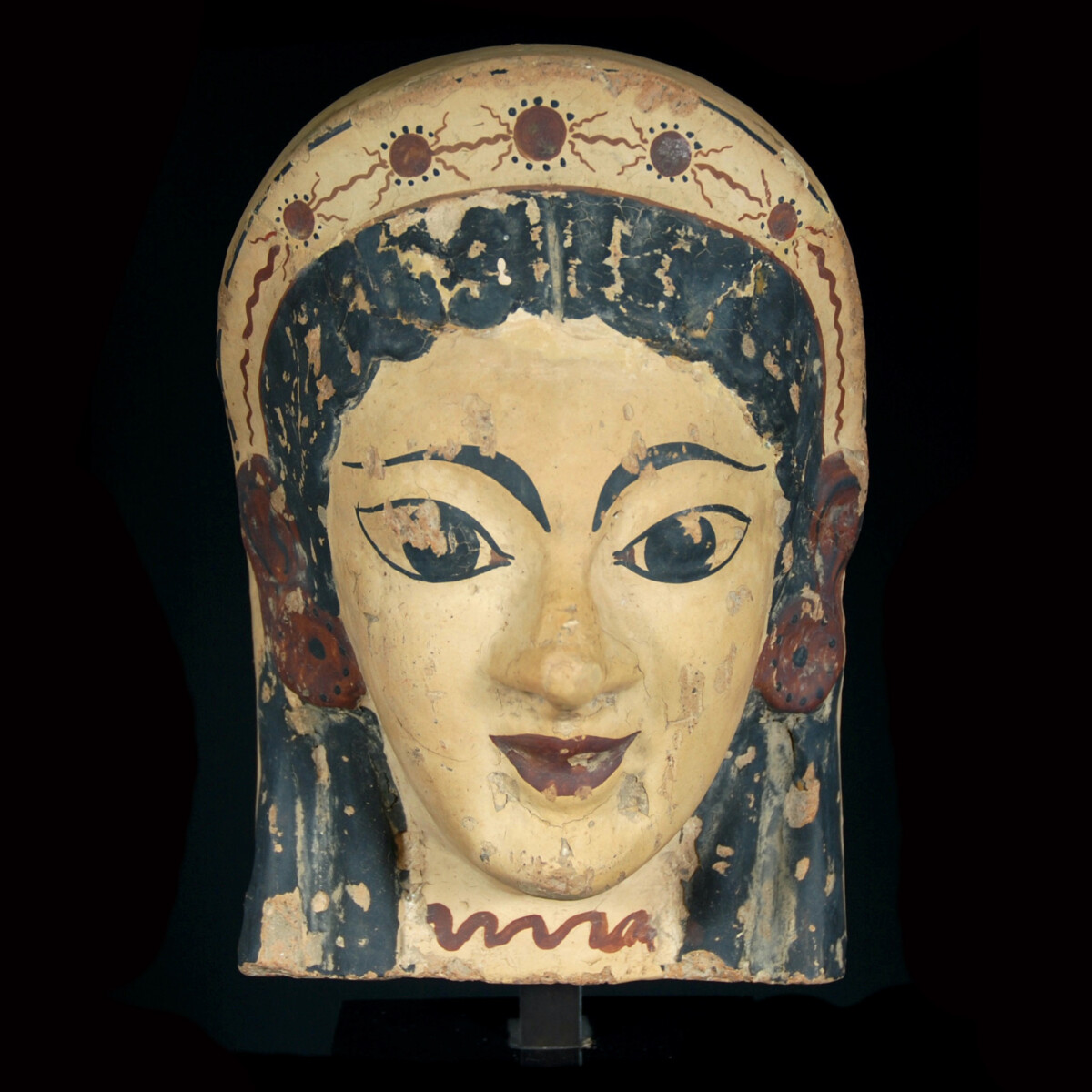
|
|
|
|
|
Magnificent terracotta antefix in form of an archaic female head with beautifully preserved paint. The oval head with large, wide open, almond-shaped eyes with black pupils, above finely drawn brows, and a straight, slightly pointy nose. The mouth is small, but elegantly formed with red full lips. The black, wavy hair is parted in the middle and cascades behind the ears in Egyptian style to the shoulders. The woman wears large round earrings, which are painted in red like the ears and in addition have black dotted decoration. Above the forehead towers a stephane which is decorated with sun ornaments. Finally on the neck a stylized necklace is painted in red. Possibly from Cerveteri. Mounted.
|
Provenance: Swiss private collection, 1960s. Thence with Nina Borowski 1988. There published in: “Nina Borowski Archéologie, décembre 1988 – janvier 1989”, pl. III, Nr. 1. There acquired from the French entrepreneur and art patron Pierre Bergé (1930-2017). Thence auctioned with Pierre Bergé auctions, there acquired by an Austrian art dealer. Last in the private collection of Sigrid Fiebig, Bad Herrenalb, Germany, acquired on 4 March 2019. With original invoice and certificate.
Dimensions: 21 cm high
Price: 12 000 Euro
|
|
|
|
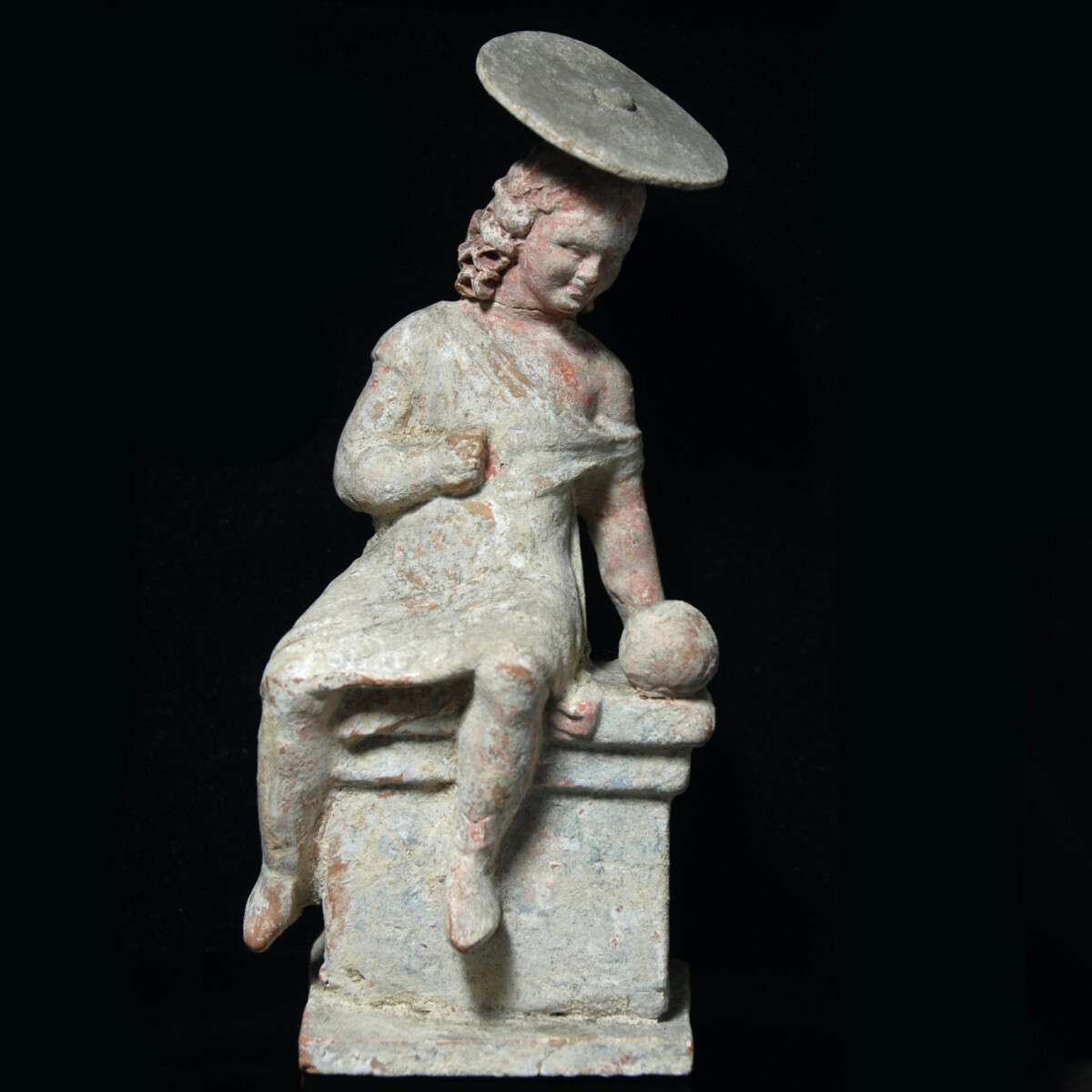
|
|
|
|
|
|
|
|
Greece – 4th-3rd century B.C.
|
A touching, sculptural terracotta statuette from Tanagra depicting a girl seated on an altar lost in thoughts. The girl wears a short tunic which falls over her left shoulder, as well as a large, round sun hat with a pointy centre. She has long, curly, reddish colored hair, which reaches on the back to her nape. She is gazing downwards. Possibly she is looking at the ball which is next to her in the corner of the altar. Her face has friendly, melancholic features, a hint of a smile is recognizable. The statuette stands on a belonging, square plinth. With a TL test of 23 October 2021 confirming the age of the statuette.
|
Provenance: From the private collection of the French archaeologist Louis-Gabriel Bellon (1819-1899). For over 120 years in a family estate. With a TL test and a French antiquities passport.
Dimensions: 16.5 cm high
Price: 8 800 Euro
|
|
|
|
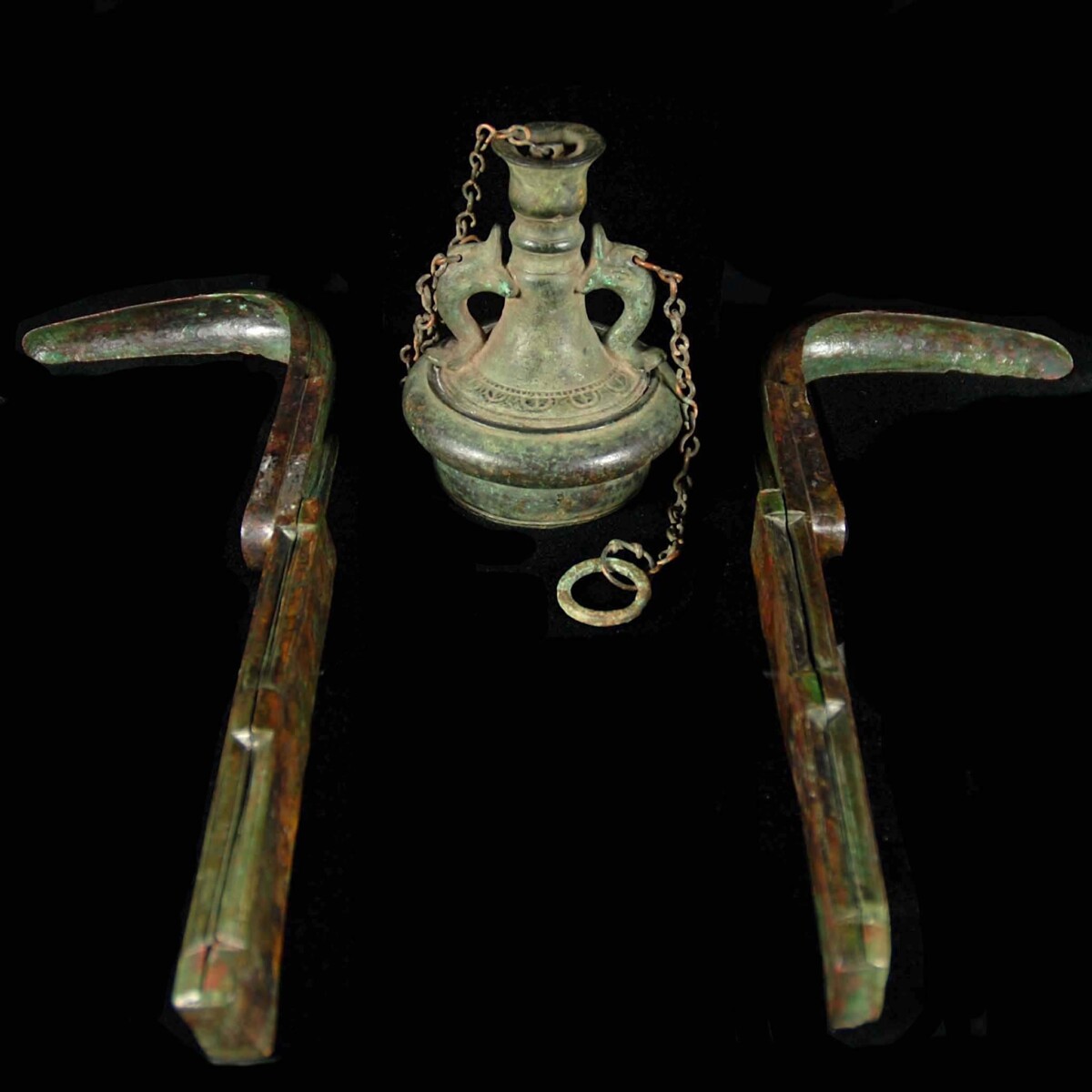
|
|
|
|
|
|
Roman Empire – 1st-2nd century A.D.
|
Two bronze strigils and a bronze aryballos form an extremely rare, completely preserved Roman cleansing set. In the aryballos oil was stored which was applied on the body. Afterwards both strigils were used to scrap off the oil from the skin. In ancient times soap was not known therefore this kind of body cleaning was very popular. Both strigils are very finely worked out, with rectangular handles and a scraper bent at right angles with lancet-shaped serrations on the outside. The aryballos with a compressed corpus, flat basis with concentric circles and a tongue pattern on the shoulder. Both vertical handles are worked out in form of dolphins and applied on the aryballos corpus. Bronze chains hang from the perforated dorsal fins of the dolphins, one of which is still intact, the other with only a few chain links. The aryballos was attached to the belt and carried using these bronze chains. The cylindrical neck with a central ridge, the spout still has the removable original lid, to which a bronze chain is also attached through an eyelet.
|
Provenance: Old German private collection, thence Antikenkabinett Gackstätter, Frankfurt, Germany. From there acquired by the French collection Gilles Grimm on 21 June 2010.
Dimensions: 23 cm long (strigils); 10 cm high (aryballos)
Price: 6 000 Euro
|
|
|
|
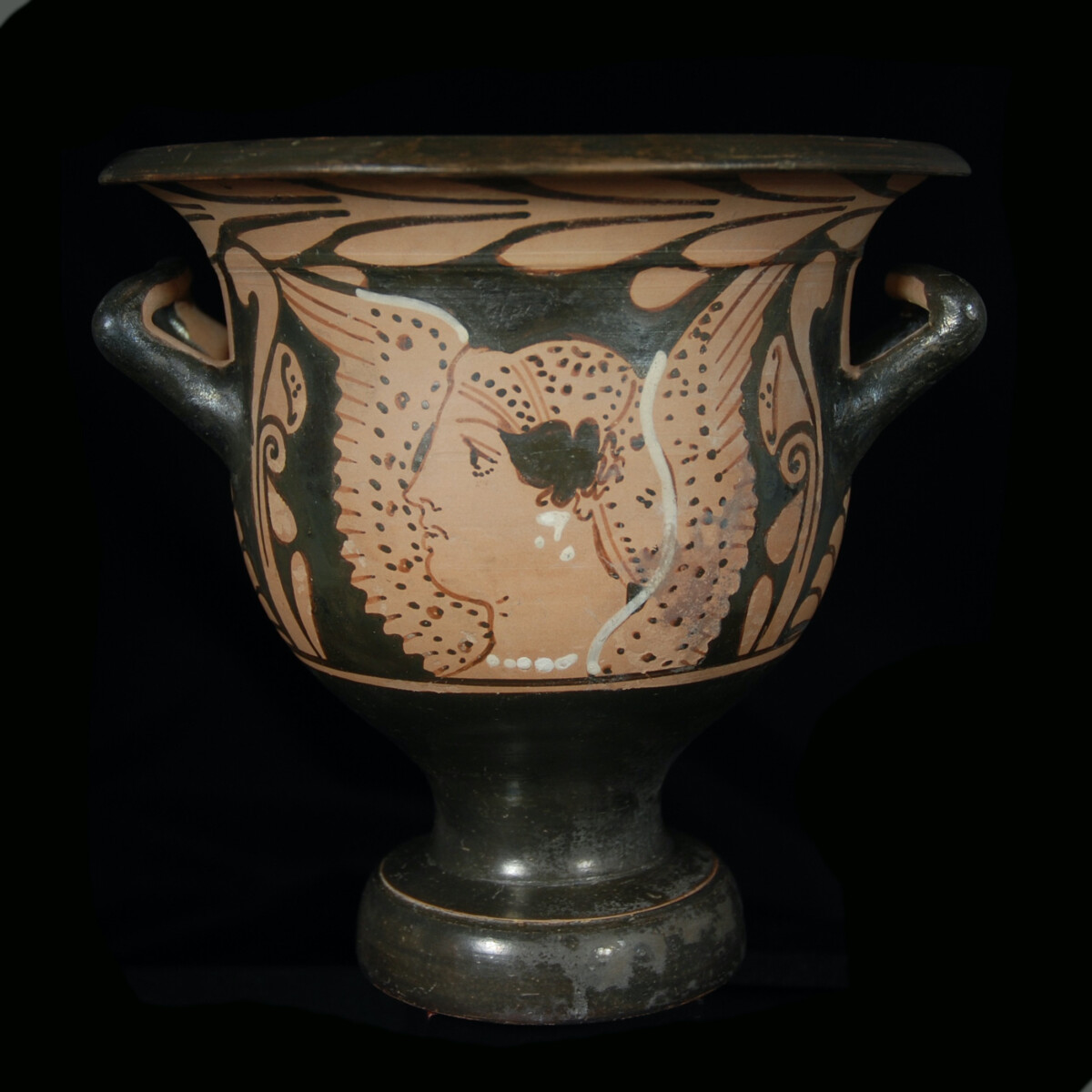
|

|
|
Greece/Campania – 340-320 B.C.
|
Wonderfully preserved, small Campanian bell krater of the Caivano Painter. The front depicts a winged goddess in profile facing to the left between two flower ornaments, typical for this painter. She wears a dotted sakkos, underneath along the temple a thick black hair bundle is looking out. Earrings and necklace are painted in opaque white. The open wings are also decorated with dots, the feathers are accentuated outwards. This could be the depiction of Iris, the messenger of the gods and servant of Hera, who is often shown with a sakkos. On the other side a straight standing, mythological animal, possibly a panther to the left, again between the typical calyxes of the Caivano Painter. Below the rim encircling laurel leaves. See for the flower ornaments of the Caivano Painter the lebes gamikos in the British Museum with the museum number 1756,0101.490.
|
Provenance: Belgian private collection since 1963. Last in a German private collection Sigrid Fiebig, Bad Herrenalb, acquired on 17 November 2014. With the original invoice and certificate.
Dimensions: 18.3 cm high; 18.5 cm in diameter
Price: 4 800 Euro
|
|
|
|
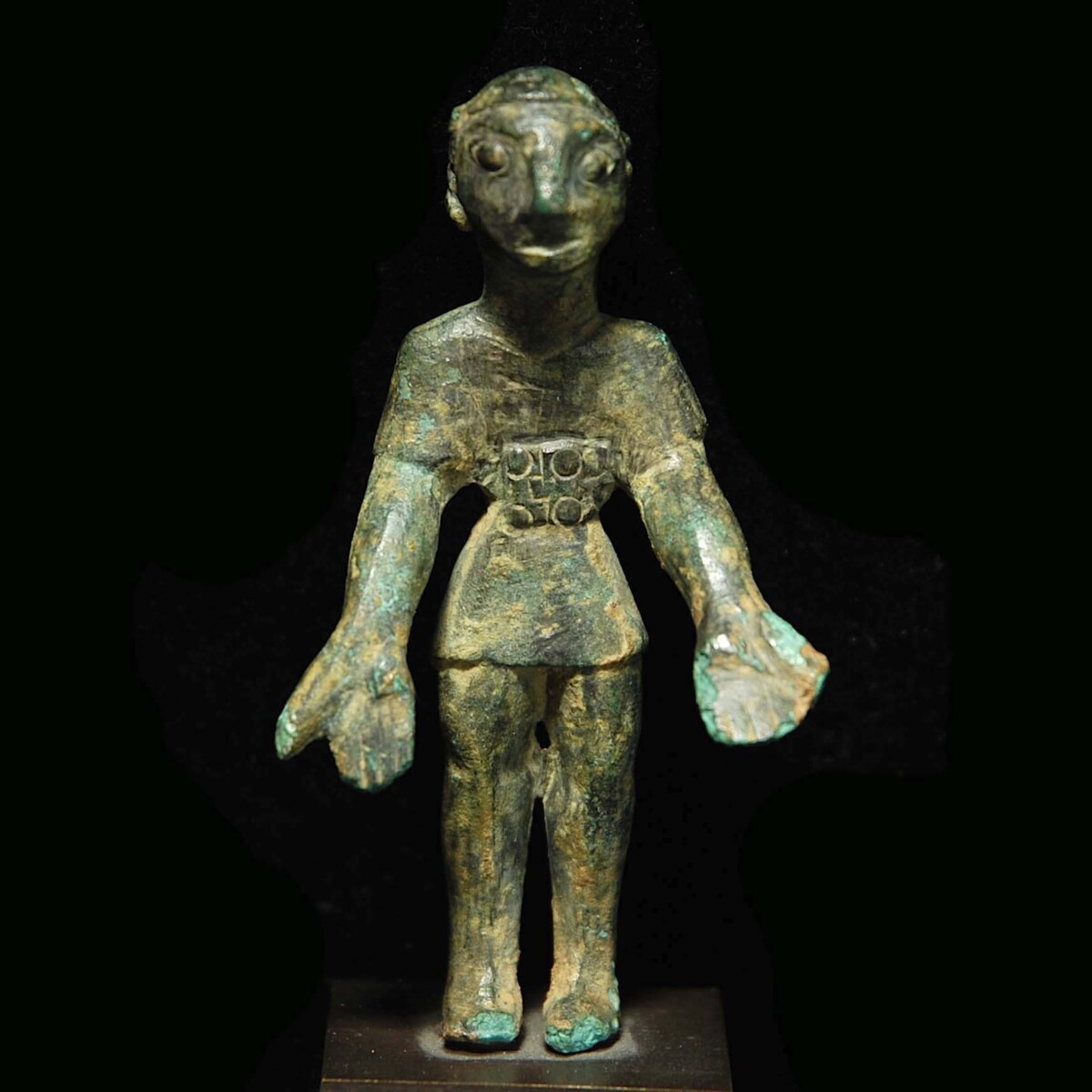
|
|
|
|
|
|
Iberia – Mid 1st milllennium B.C.
|
Massive cast bronze idol of a man in a praying posture. The slightly spread legs touching each other on the knees. The man has his overlong arms stretched out sideways, with open palms facing upwards. He wears a short tunic, hold together by a broad belt. The rectangular belt buckle is decorated with circles in the corners. The spherical head with almond-shaped eyes, broad mouth and a prominent nose. His hair is flat on the calotte, braided pigtails cascade behind the ears and along the back of the head. Bronze votive statuettes like the present one were found in a sanctuary in the southern Spanish province Jaén. See for reference the statuettes in the Musée des Antiquités Nationales in Saint-Germain-en-Laye with the inventory numbers 77876.57 and 77876.60, published in: “Die Iberer”, Bonn 1997, page 343, numbers 289 and 290. Mounted.
|
Provenance: From an old Munich collection, acquired from a German auction house.
Dimensions: 6.6 cm high
Price: 4 000 Euro
|
|
|
|
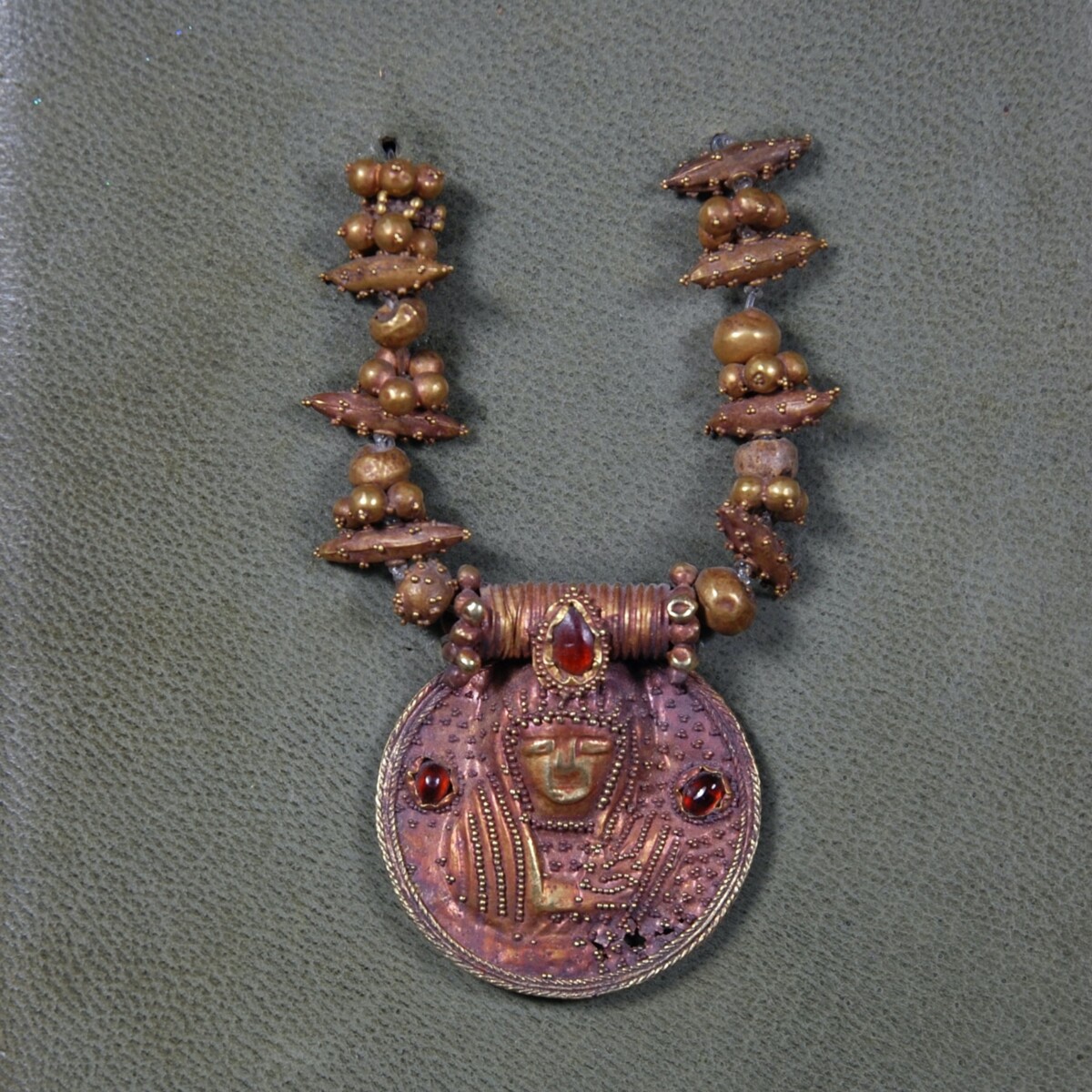
|
|
Byzantine Empire – 7th-8th century A.D.
|
Important Byzantine gold pendant consisting of a round medallion, gold beads of different forms and sizes and inlayed garnets. The medallion with a portrait, embossed on a gold sheet, of an important woman, possibly an empress. The pleats of her veil, the garment and the necklace are accentuated with diligently inlayed garnets. On her forehead a large inlayed garnet. Left and right of the bust two more inlayed garnets. The medallion hangs on an elongated gold spiral, which is framed on both sides by garnet rings. Adjacent gold beads of different forms and sizes, throughout adorned with garnets. The important pendant is on a leather mount from where it can easliy be removed and be set in a modern necklace.
|
Provenance: From the estate of the French art dealer Evrard de Rouvre (1923-1979). Thence with his daughter Isabelle and her husband Francois van den Broeck. Since then in the family estate.
Dimensions: 6.3 cm high
Price: 3 600 Euro
|
|
|
|
|
|
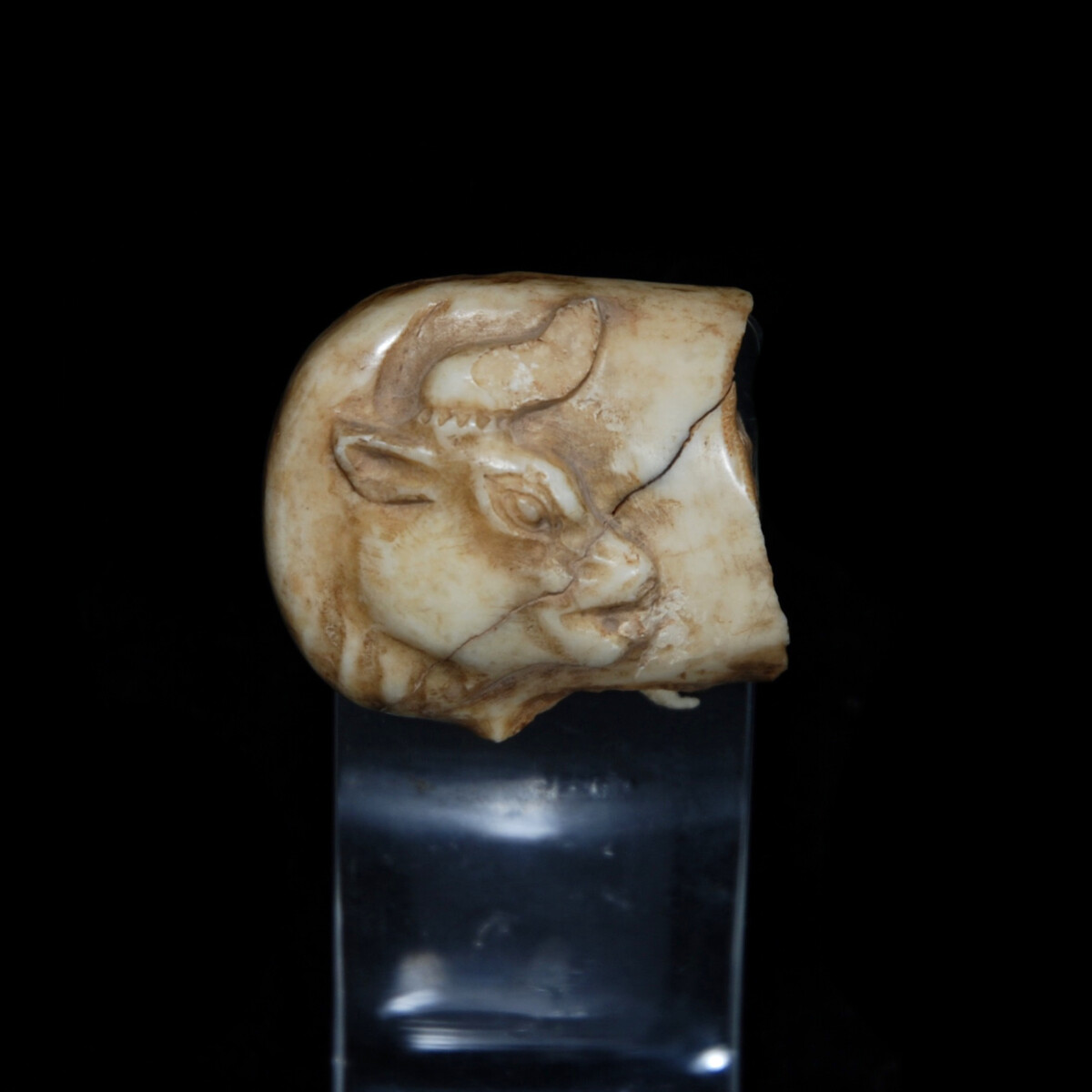
|
|
Asyyrian Empire – 9th-8th century B.C.
|
Bone relief worked out in high-quality with the depiction of a cow. The head of the animal turned backwards, the horns are bent forward. The large eye framed by thick eyelid margins looking downwards. At the neck bottom remains of a notched, ragged mane. Reliefs such as the present one are known from the palace of the Assyrian king Aššur-nâṣir-apli II in Nimrud. They depict a cow licking the suckling calf. A nearly complete relief is today in the Museum in Aleppo with the inventory number 349. These reliefs were crafted in Phoenician workshops. They were popular as inlays of high quality furniture in ruling houses in the Levante and Assyria. Mounted.
|
Provenance: From the old German collection Becker, 1980s. Thence with Antikenkabinett Gackstätter with the list number 01390. Last in a Munich collection of idols. With the original certificate of Antikenkabinett Gackstätter.
Dimensions: 3.2 cm x 3.7 cm
Price: 1 600 Euro
|
|
|
|
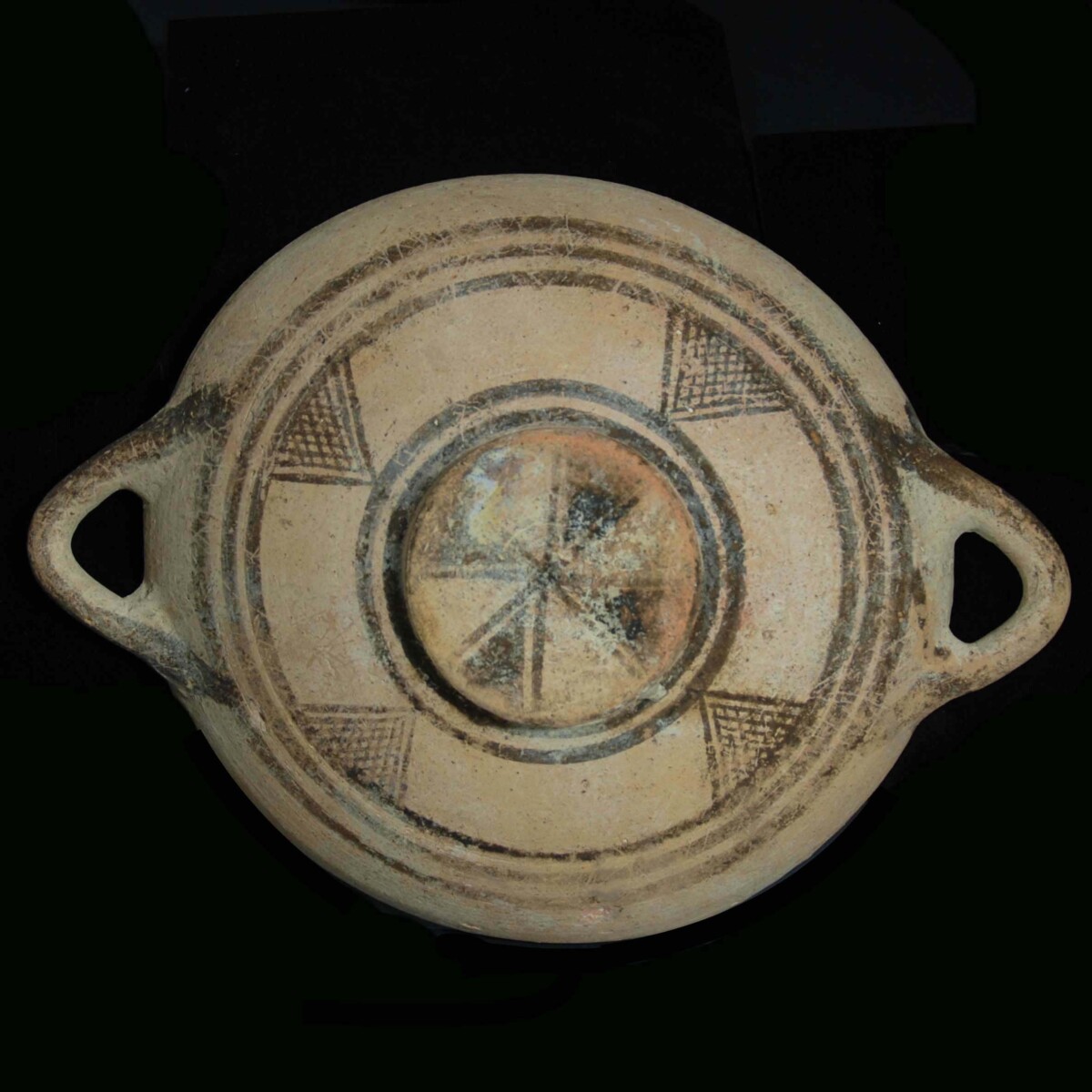
|
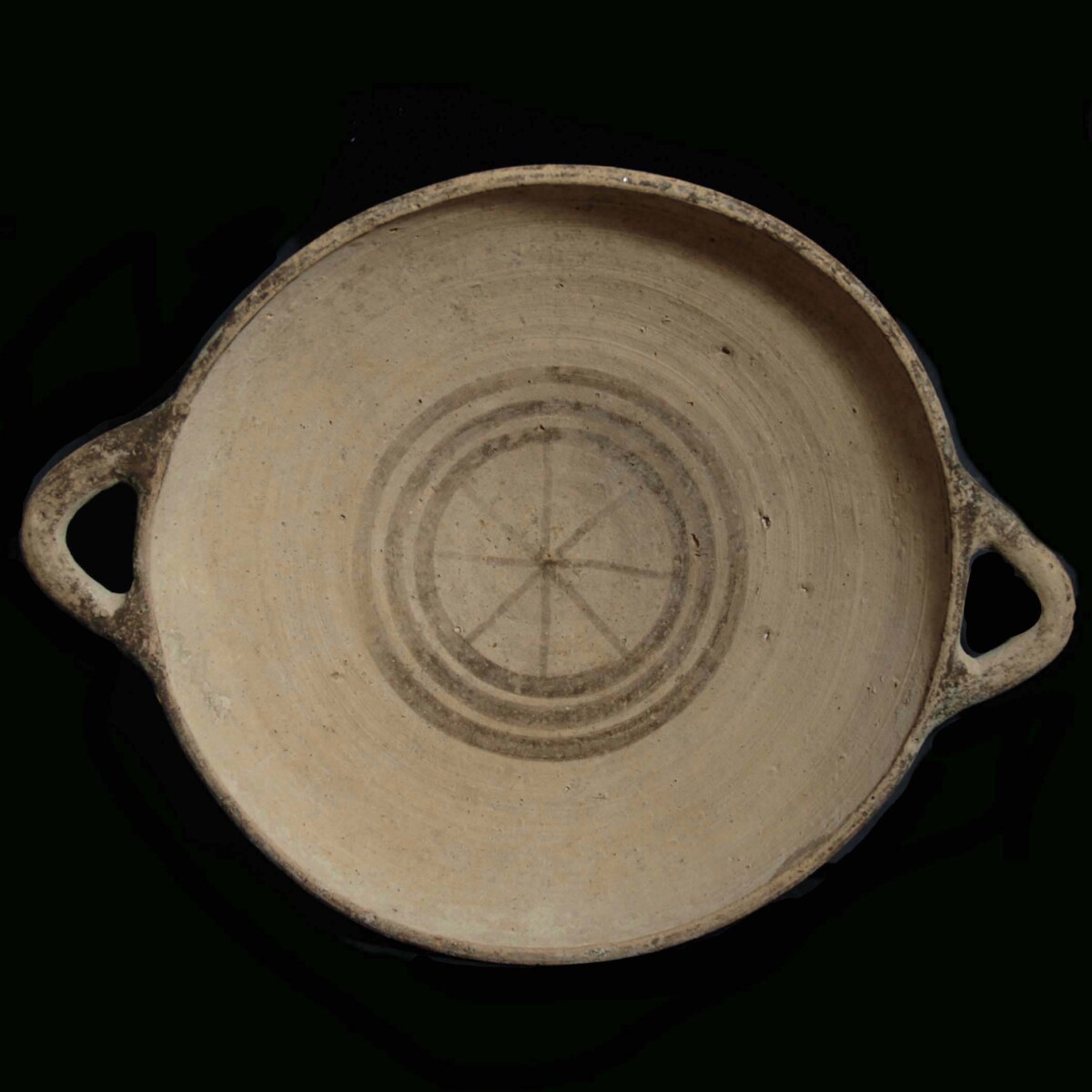
|
Flat bowl on a ring foot with a horizontally protruding, semi-circular handle. The inside and outside with black geometrical paint on a white background. Inside star decoration framed by three concentrical circles. On the foot a cross pattée, below concentrical circles. Followed by four triangles with net decoration, framed by three more concentrical circles. The bottom of the handle is black.
|
Provenance: German private collection O. Schwarzwälder, acquired 1980.
Dimensions: 27.7 cm in diameter including handles
Price: 1 200 Euro
|
|
|
|
|
|
|
Roman Empire – 2nd century A.D.
|
Large square clay brick with a two-line Roman cursive inscription carved in the soft clay. It reads II KAT IULIAS and below the name of the potter SECUNDIANUS. The first line mentions the date of the production, converted 30 June. The brick was found during construction works in Wels, the Roman city of Ovilava. A rare testimony of Roman daily life writing from present Austria. Mounted.
|
Provenance: Collection Josef Wagner (1931-1999). Last in a family estate. Found between the 1970s to 1980s.
Dimensions: 25 cm x 25.8 cm
Price: 800 Euro
|
|
|
|
|
|
Besuchen Sie uns bei den
Salzburger Festspielen von 13. bis 21. August!
|
|
Die Vorbereitungen laufen auf Hochtouren: Auch in diesem August treffen sich wieder Kunstsammler, Interessierte und Connaisseurs im sommerlichen Salzburg, um eines der bedeutendsten Kultur-Festivals der Welt zu besuchen – die Salzburger Festspiele. Auf der parallel dazu stattfindenden ART&ANTIQUE zeigen renommierte Kunsthändler aus ganz Europa von 13. bis 21. August ihre Meisterwerke im Hof der Residenz.
|
|
|
|
Unser Highlight des Monats:
|
|
Ägypten – Spätzeit, 26. Dynastie, 664-525 v. Chr.
|
Überaus dekorativer sowie farbenfroh bemalt und beschriebener Sarkophagdeckel aus der 26. Dynastie. Die Inschrift nennt als Besitzer den göttlichen Vater Wennefer, Sohn des göttlichen Vaters des Amun mit dem Namen Min-ir-dis, geboren von der Hausherrin Djet-Mut. Das Gesicht rot bemalt, Augen, Brauen und Bartriemen in Schwarz. An der Unterseite des Gesichts eine Aussparung für den separat gearbeiteten falschen Bart, der heute verloren ist. Die dreiteilige Perücke ist gestreift, die Ohren stehen hervor. Der breite Halskragen endet an den Schultern mit Falkenköpfen. Darunter die Figur der geflügelten Himmelsgöttin Nut, ihr Name in Hieroglyphen innerhalb der Sonnenscheibe, die sie auf dem Kopf trägt. Am linken Rand des Sarkophags ein grün gemalter Widder mit wellenförmigen Hörnern, Federkrone und roter Sonnenscheibe. Darunter eine Szene mit der Göttin Maat und dem Gott Thot, die den Verstorbenen vor den thronenden Osiris bringen. Hinter Osiris eine Prozession verschiedener Götter und Göttinnen, vor ihm Opfergaben. Darunter rahmen zahlreiche Inschriften in Bändern und Spalten eine zentrale Szene ein, die den Verstorbenen auf einer Bahre mit Löwenköpfen zeigt. Darunter zwei Kanopenkrüge, darüber ein fliegender Ba, der das Kapitel 89 des Totenbuches illustriert, in dem die Seele („Ba“) sich wieder dem Körper vereint. An den Außenseiten Darstellungen der vier Horussöhne. Im unteren Bereich weisen Reste einer gräulichen Übermalung mit Inschriften darauf hin, dass der Sarkophag in der Antike mehrfach verwendet wurde. Gesockelt.
|
Provenienz: Belgische Privatsammlung, erworben aus der Sammlung Fris, Holland, im Jahre 1980.
Höhe: 135 cm
Price: 48.000 Euro
|
|
|
|
Ausgewählte Kunstwerke des Monats:
|
|
Etrurien – 525-500 v. Chr.
|
Prachtvolles Terrakotta-Antefix in Form eines archaischen Frauenkopfes mit schön erhaltener Bemalung. Der ovale Kopf mit großen, weit geöffneten, mandelförmigen Augen mit schwarzer Pupille, fein geschwungenen Brauen darüber und einer gerade, etwas spitzen Nase. Der Mund klein, aber elegant geformt mit roten vollen Lippen. Das schwarze, wellige Haar ist in der Mitte gescheitelt und fällt hinter den Ohren im ägyptisierenden Stil auf die Schultern. Die Frau trägt große runde Ohrringe, die wie die Ohren selbst rot gefärbt sind und zusätzlich schwarzes Punktdekor aufweisen. Über die Stirn ragt eine Stephane, die mit roten Sonnenornamenten verziert ist. Am Hals ist schließlich eine stilisierte Halskette in Rot aufgemalt. Wohl aus Cerveteri. Gesockelt.
|
Provenienz: Privatbesitz Schweiz, 1960er Jahre. Danach bei Nina Borowski 1988. Dort publiziert in: „Nina Borowski Archéologie, décembre 1988 – janvier 1989“, pl. III, Nr. 1. Dort erworben vom französischen Unternehmer und Kunstmäzen Pierre Bergé (1930-2017). Danach versteigert bei Pierre Bergé Auktionen, dort erworben von einem österreichischen Kunsthändler. Zuletzt in der Privatsammlung Sigrid Fiebig, Bad Herrenalb, erworben am 4. März 2019. Mit Original-Rechnung und -Zertifikat.
Höhe: 21 cm
Preis: 12.000 Euro
|
|
|
|
|
Griechenland – 4.-3. Jahrhundert v. Chr.
|
Berührende vollplastische Terrakotta-Statuette aus Tanagra, die ein auf einem Altar sitzendes Mädchen, ganz in Gedanken versunken zeigt. Das Mädchen trägt eine kurze Tunika, die ihr über die linke Schulter gefallen ist sowie einen großen, runden Sonnenhut mit spitzer Mitte. Sie hat langes, gelocktes, rötlich gefärbtes Haar, das ihr hinten bis in den Nacken fällt. Ihr Blick ist nach unten gerichtet. Vielleicht blickt sie auf den Ball, der in der Ecke des Altars neben ihr liegt. Ihr Gesicht hat freundliche, melancholische Züge, ein Hauch eines Lächelns ist erkennbar. Die Statuette steht auf einer zugehörigen, quadratischen Plinthe. Mit TL-Test vom 23. Oktober 2021, der das Alter der Statuette bestätigt.
|
Provenienz: Aus der Privatsammlung des französischen Archäologen Louis-Gabriel Bellon (1819-1899). Seit über 120 Jahren in Familienbesitz. Mit TL-Test und französischem Antikenpass.
Höhe: 16,5 cm
Preis: 8.800 Euro
|
|
|
|
|
Römisches Reich – 1.-2. Jahrhundert n. Chr.
|
Zwei bronzene Strigilis und ein Bronze-Aryballos bilden ein überaus seltenes, komplett erhaltenes römisches Reinigungsset. Im Aryballos wurde das Öl aufbewahrt, das auf dem Körper aufgetragen wurde. Die beiden Strigilis wurden dann dazu verwendet, das Öl von der Haut abzuschaben. Da man in der Antike keine Seife kannte, war diese Art der Körperreinigung weit verbreitet. Die beiden Strigilis sind besonders fein gearbeitet, mit rechteckigem Griff und einem im rechten Winkel gebogenen Schaber mit lanzettförmigen Riefelungen an der Außenseite. Der Aryballos mit gestauchtem Korpus, flacher Basis mit konzentrischen Kreisen und einem Zungenmuster auf der Schulter. Die beiden vertikalen Henkel sind in Form von Delphinen gearbeitet und appliziert. In den gelochten Rückenflossen der Delfine hängen Bronzeketten, eine davon ist noch vollständig erhalten, die andere nur mit ein paar Kettengliedern. Über diese Bronzeketten wurde der Aryballos am Gürtel befestigt und getragen. Der zylindrische Hals mit Mittelgrat, am Ausguss sitzt noch der abnehmbare Original-Deckel, an dem über eine Öse ebenfalls eine Bronzekette befestigt ist.
|
Provenienz: Alte deutsche Privatsammlung, danach Antikenkabinett Gackstätter, Frankfurt. Dort erworben von der französischen Sammlung Gilles Grimm am 21. Juni 2010.
Dimensionen: Länge Strigilis je 23 cm; Höhe Aryballos 10 cm
Preis: 6.000 Euro
|
|
|
|
|
Griechenland/Kampanien – 340-320 v. Chr.
|
Wunderbar erhaltener, kleiner kampanischer Glockenkrater des Caivano-Malers. Die Vorderseite zeigt eine geflügelte Göttin im Profil nach links zwischen zwei für diesen Maler typischen Blumenornamenten. Sie trägt einen gepunkteten Sakkos, unter dem an der Schläfe ein dichtes schwarzes Haarbüschel hervorquillt. Ohrschmuck und Halskette sind in Deckweiß aufgetragen. Die aufgerichteten Flügel sind ebenfalls mit Punkten dekoriert, die Federn sind nach außen hin akzentuiert. Es könnte sich hier um die Götterbotin und Dienerin der Hera Iris handeln, die häufig mit Sakkos dargestellt wird. Die andere Seite zeigt ein aufrecht stehendes, mythologisches Tier, wohl einen Panther, nach links, erneut zwischen den typischen Blütenkelchen des Caivano-Malers. Unter dem Rand umlaufende Lorbeerblätter. Vergleiche zu den Blumenornamenten des Caivano-Malers den Lebes Gamikos im British Museum mit der Museum number 1756,0101.490.
|
Provenienz: Belgische Privatsammlung seit 1963. Zuletzt in der deutschen Privatsammlung Sigrid Fiebig, Bad Herrenalb erworben am 17. November 2014. Mit Originalrechnung und Zertifikat.
Dimensionen: Höhe 18,3 cm; Durchmesser 18,5 cm
Preis: 4.800 Euro
|
|
|
|
|
Iberische Halbinsel – Mitte 1. Jahrtausend v. Chr.
|
Massiv gegossenes Bronze-Idol eines Mannes im Gebetsgestus. Die leicht gespreizten Beine berühren sich an den Knien. Der Mann hat seine überlangen Arme seitlich ausgestreckt, mit offenen, nach vorne weisenden Handflächen. Er trägt eine kurze Tunika, die von einem breiten Gürtel zusammengehalten wird. Die rechteckige Gürtelschnalle ist mit Kreisen in den Ecken verziert. Der kugelige Kopf mit mandelförmigen Augen, breitem Mund und prägnanter Nase. Das Haar ist oben auf der Kalotte glatt anliegend, hinter den Ohren und am Hinterkopf fallen geflochtene Zöpfe herab. Bronzevotiv-Statuetten wie diese wurden in einem Heiligtum in der südspanischen Provinz Jaén gefunden. Vergleiche dazu die Statuetten im Musée des Antiquités Nationales in Saint-Germain-en-Laye mit den Inventarnummern 77876.57 und 77876.60, publiziert in: „Die Iberer“, Bonn 1997, Seite 343, Nummer 289 und 290. Gesockelt.
|
Provenienz: Aus alter Münchner Sammlung, erworben in einem deutschen Auktionshaus.
Höhe: 6,6 cm
Preis: 4.000 Euro
|
|
|
|
|
Byzantinisches Reich – 7.-8. Jahrhundert n. Chr.
|
Bedeutender byzantinischer Goldanhänger, der aus einem runden Medaillon, Goldperlen verschiedener Form und Größe und eingelegten Granaten besteht. Das Medaillon mit aus einem Goldblech getriebenen Porträt einer bedeutenden Frau, wohl einer Kaiserin. Die Falten ihres Schleiers, des Gewands und der Halsschmuck durch sorgfältig aufgelegte Granulate akzentuiert. Auf ihrer Stirn ein großer eingelegter Granat. Links und rechts der Büste zwei weitere eingelegte Granulate. Das Medaillon hängt auf einer länglichen Goldspirale, die auf beiden Seiten von Granulatringen begrenzt wird. Daran anschließend Goldperlen verschiedener Form und Größe, durchwegs mit Granulaten besetzt. Der bedeutende Anhänger ist an einem Lederstand montiert, von dem er problemlos abgenommen und an eine moderne Halskette montiert werden kann.
|
Provenienz: Aus dem Nachlass des französischen Kunsthändlers Evrard de Rouvre (1923-1979). Danach im Besitz seiner Tochter Isabelle und ihres Mannes Francois van den Broek. Seitdem in Familienbesitz.
Höhe: 6,3 cm
Preis: 3.600 Euro
|
|
|
|
|
Assyrisches Reich – 9.-8. Jahrhundert v. Chr.
|
Hochwertig gearbeitetes Bein-Relief mit der Darstellung einer Kuh. Der Kopf des Tieres ist nach hinten gewandt, die Hörner sind nach vorne gebogen. Das große, von dicken Lidrändern gerahmte Auge blickt nach unten. An der Halsunterseite die Reste einer eingekerbten, strähnigen Mähne. Reliefs wie dieses sind aus dem Palast des assyrischen Königs Aššur-nâṣir-apli II. in Nimrud bekannt. Sie zeigen eine Kuh, die das an ihr säugende Kalb ableckt. Ein annähernd vollständiges Relief befindet sich heute im Metropolitan Museum of Art in New York mit der Accession Number 64.37.3. Ein weiteres im Museum in Aleppo mit der Inventarnummer 349. Gefertigt wurden diese Reliefs in phönizischen Werkstätten. Sie waren als Einlagen von hochwertigen Möbeln in den Herrscherhäusern der Levante und Assyriens beliebt. Gesockelt.
|
Provenienz: Aus der alten deutschen Sammlung Becker, 1980er Jahre. Danach bei Antikenkabinett Gackstätter mit der Listennummer 01390. Zuletzt in einer Münchner Sammlung von Idolen. Mit dem Original-Zertifikat des Antikenkabinetts Gackstätter.
Dimensionen: 3,2 cm 3,7 cm
Preis: 1.600 Euro
|
|
|
|
|
Zypern – 1050-750 v. Chr.
|
Flache Schale auf Ringfuß mit horizontal abstehenden, halbrunden Henkel. Die Innen- und Außenseite mit schwarzer geometrischer Bemalung auf weißem Grund. Innen Sterndekor umrahmt von drei konzentrischen Kreisen. Am Fuß ein Tatzenkreuz, darum konzentrische Kreise. Daran anschließend vier Dreiecke mit Netzdekor, umrahmt von drei weiteren konzentrischen Kreisen. Die Unterseite der Henkel schwarz.
|
Provenienz: Deutsche Privatsammlung O. Schwarzwälder, erworben 1980.
Durchmesser mit Henkel: 27,7 cm
Preis: 1.200 Euro
|
|
|
|
|
Römisches Reich – 2. Jahrhundert n. Chr.
|
Großer quadratischer Tonziegel mit einer in den weichen Ton geritzten zweizeiligen römischen Kursivschrift. Zu lesen ist: II KAT IULIAS und darunter der Name des Töpfers SECUNDIANUS. Die erste Zeile nennt das Datum der Herstellung, umgerechnet den 30. Juni. Der Ziegel wurde bei Bauarbeiten in Wels, dem römischen Ovilava, gefunden. Ein seltenes Zeugnis römischer Alltagsschrift aus dem heutigen Österreich. Gesockelt.
|
Provenienz: Sammlung Josef Wagner (1931-1999). Seitdem in Familienbesitz. Gefunden in den 1970er- bis 1980er Jahren.
Höhe: 25 cm x 25,8 cm
Preis: 800 Euro
|
|
|
|
|
|
|
CHRISTOPH BACHER ARCHÄOLOGIE ANCIENT ART GmbH
|
Galerie: Stubenring 20, A-1010 Wien
Showroom: Untere Viaduktgasse 55, A-1030 Wien
|
|
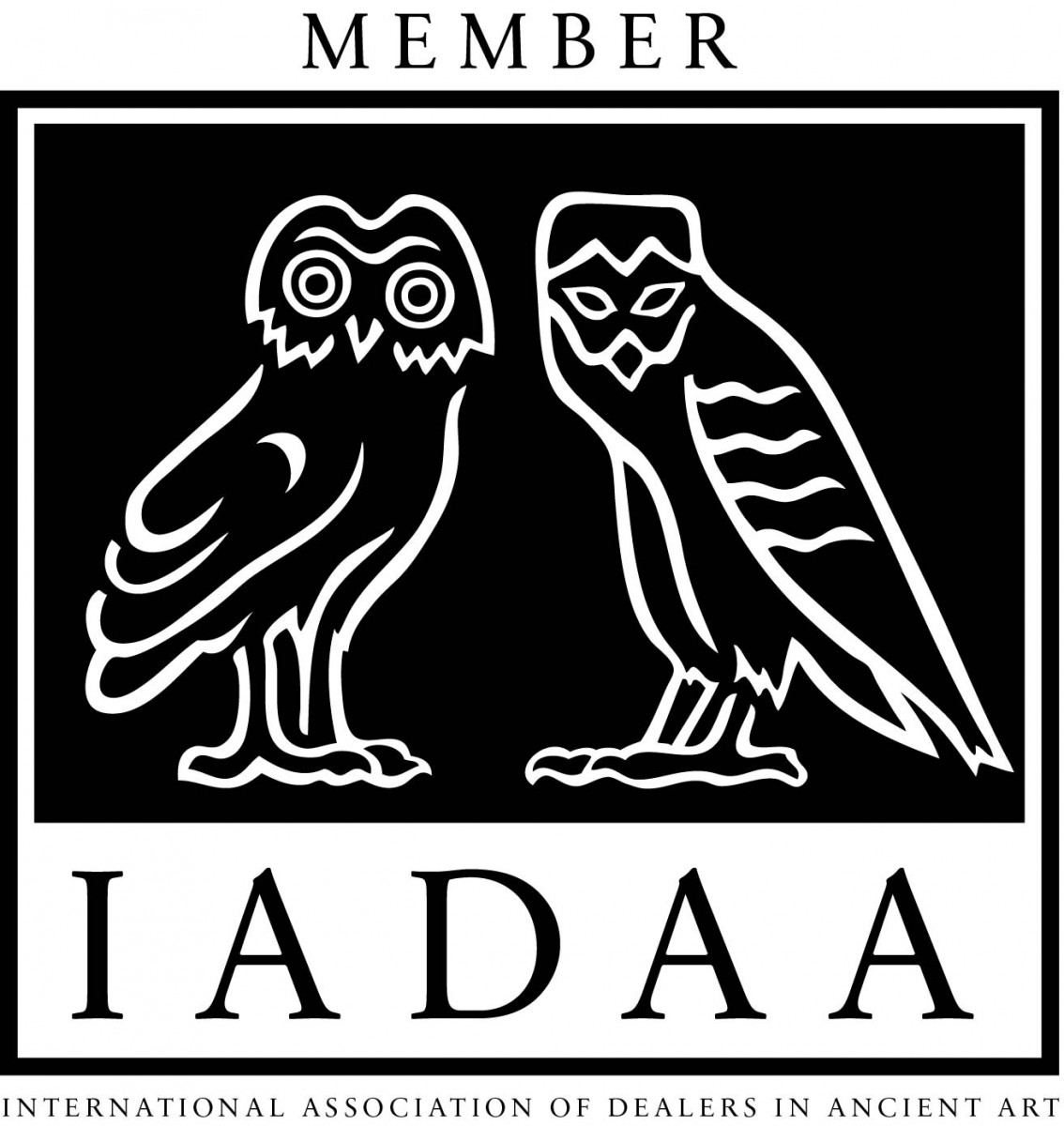
|
|
|
|